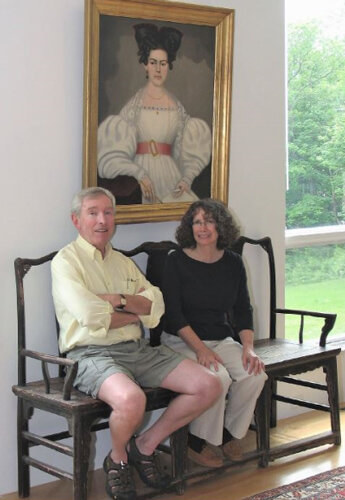143
143
Jin to Yuan Dynasty 8½ h × 8 w × 2¾ d in (22 × 20 × 7 cm)
estimate: $1,000–1,500
result: $650

Joan had always been a collector. She started buying netsukes on Saturday trips as a child, moved on to sea shells, then Bakelite, and also art books, which became a lifelong pursuit. About thirty years ago she started buying geodes and fossils, building a collection she sold to an artist and jeweler who used them in his designs.
A little over twenty years ago, she came across the Scheier's work on a trip to the Currier Gallery in Manchester, NH and she was hooked. She took a standing case of their work to the New Hampshire Antiques Show and sold the entire contents to one person. She then assembled another grouping and took it to the Folk Art Show in NYC—where she again sold the entire case to one individual. As her reputation for Scheier grew, she began advertising it in national trade publications and was asked to exhibit it as part of our booth at the Winter Show in NYC. Contemporaneously, she discovered the work of Brother Thomas Bezanson at the Pucker Gallery in Boston and began collecting his work. Then she expanded her interest to the work of other, more experimental potters and ceramicists from the last quarter of the 20th century.

Underlying these new interests was her thirty year quest with Chinese pottery from the Song period. This primarily ‘black and brown’ ware was made in many forms and was treated with a number of glazes. Tea bowls are the best known and most prized of this work, and it was Joan’s goal to have an example of every glaze pictured in the catalogs of museum collections and exhibitions. Joan continued to add additional forms of the ware, fascinated by the variety of shapes, glazes and slip decoration that the potters were able to attain with so few ingredients. Whether it was simply the shape of the piece, a pale blue/green base, ribbed vessels, cups and bowls with white rims, or pieces drizzled with a thin blue slip, it all fascinated her.
Joan was first and foremost an artist, and what she responded to in pottery was its artistic and aesthetic quality.
Joan was first and foremost an artist, and what she responded to in pottery was its artistic and aesthetic quality. She described her antiques business as a way to be a “serial collector”: buying, assembling, and selling what struck her eye. This collection is a result of her passion for art. Her Chinese pottery, in particular, is the largest collection of Song black and brown ware to be sold at one time in many years, and some of the tea bowls rival those in any museum collection. Many of the other forms are the only examples that she had seen.